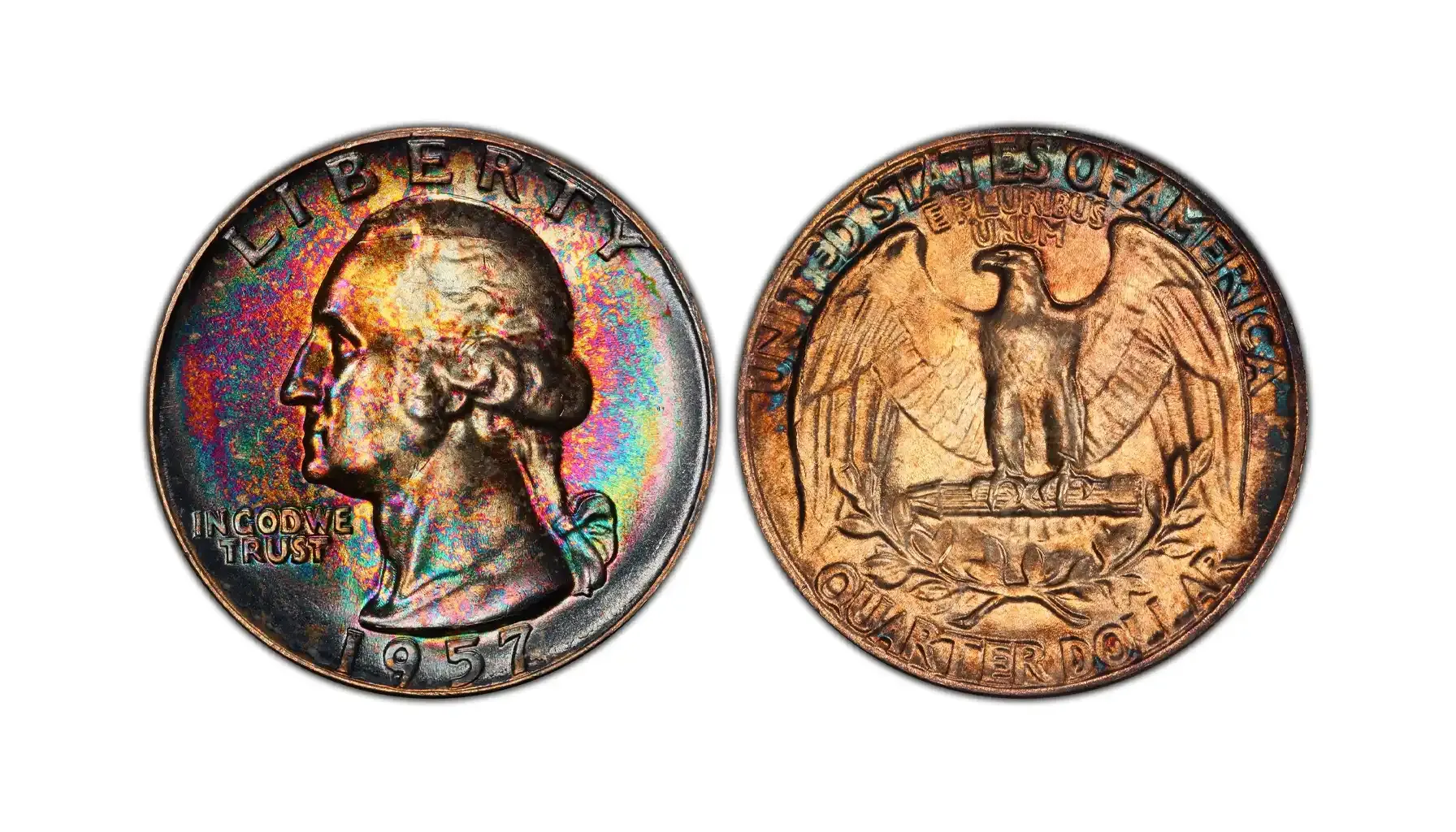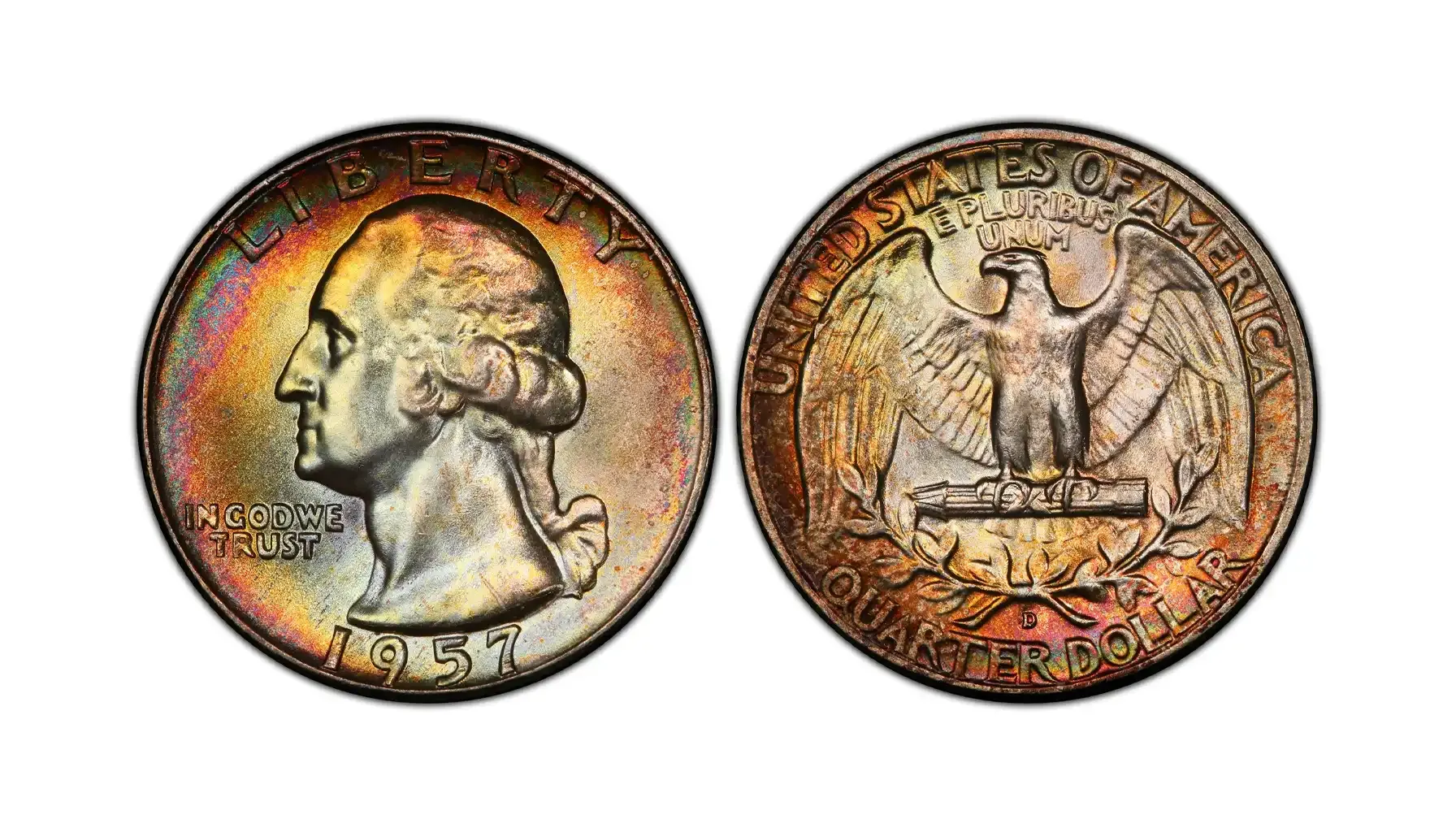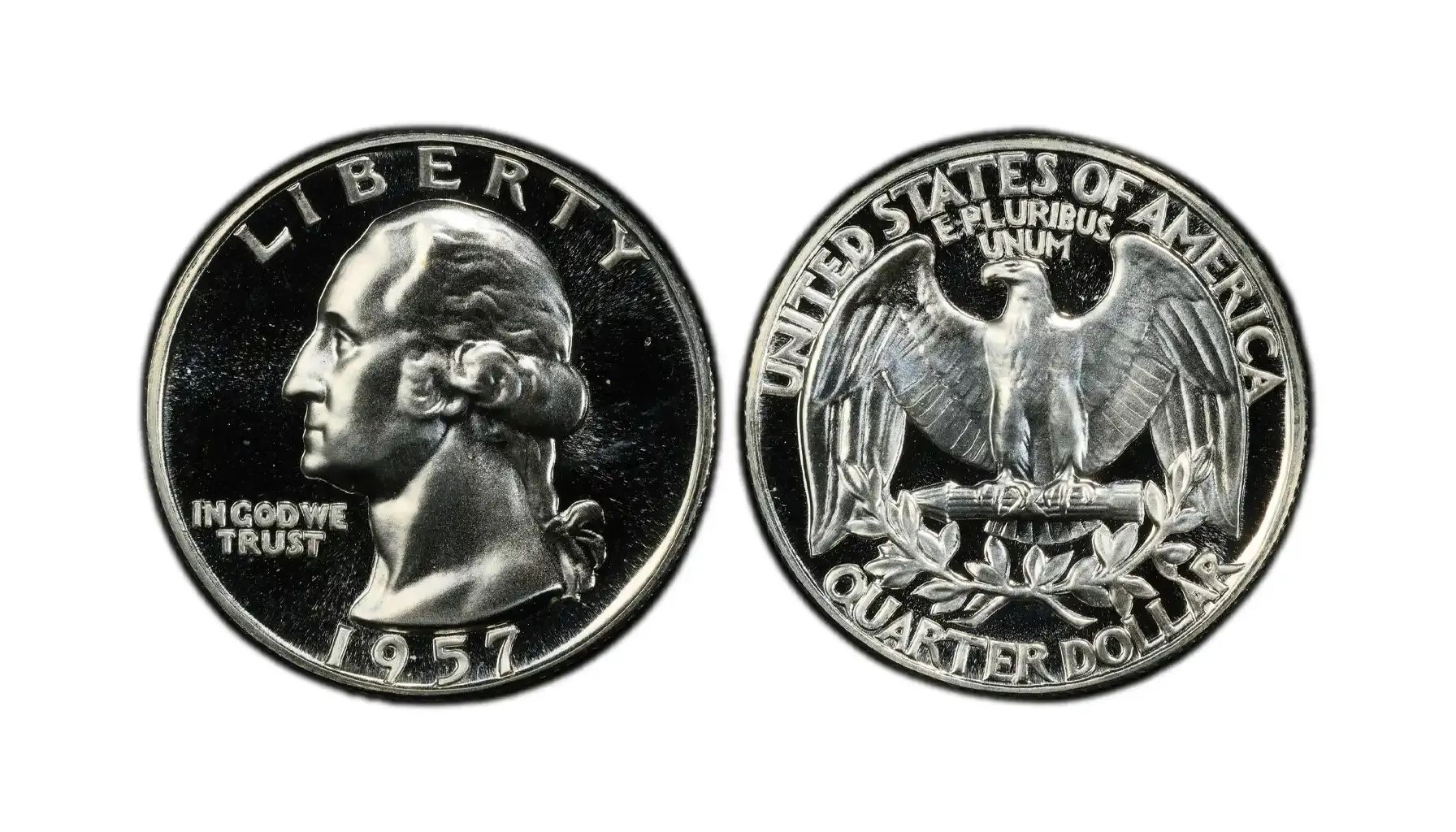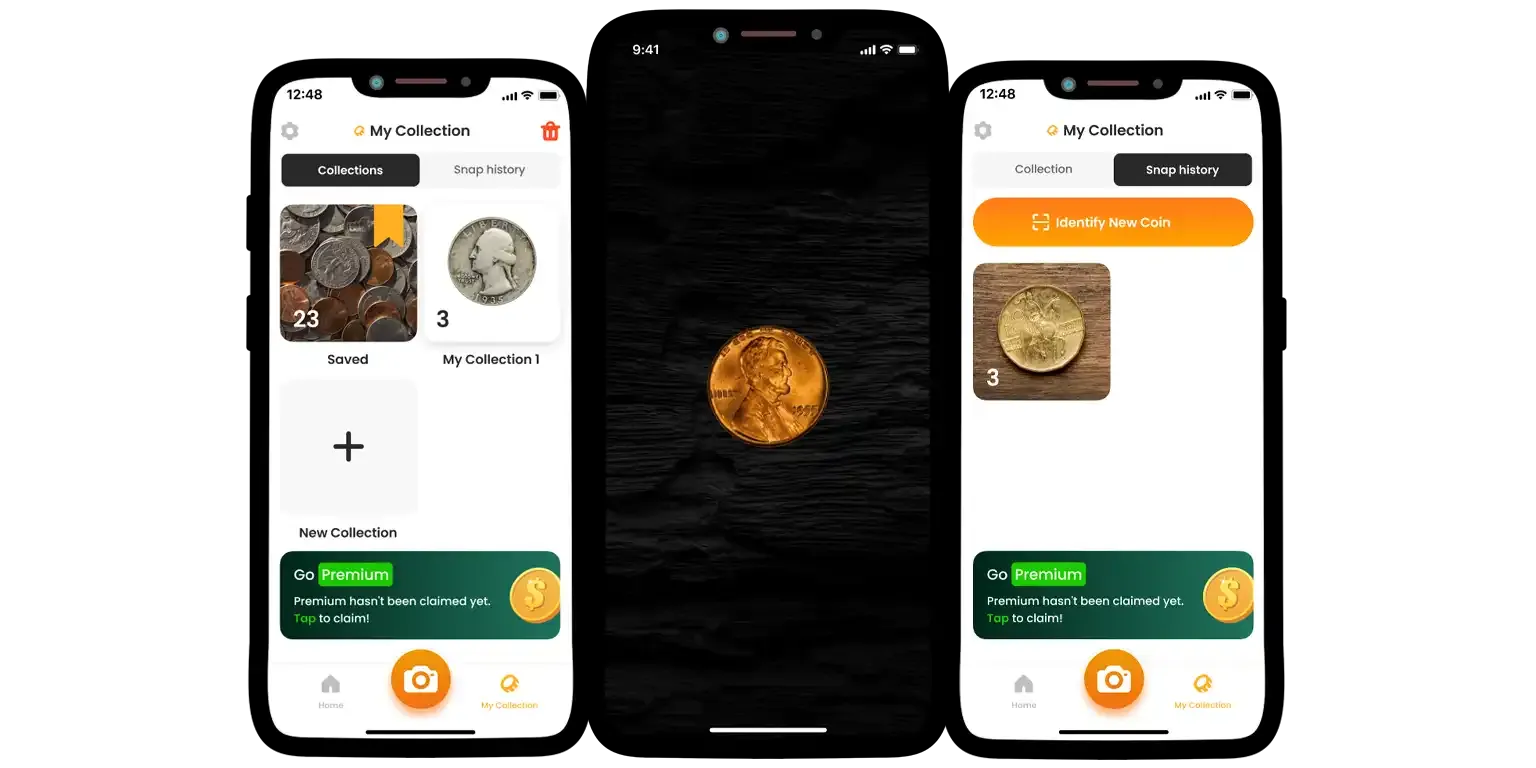Contents:
The 1957 Quarter is a Washington one, a U.S. 25-cent coin minted during the pre-clad era when quarters were made of 90% silver and 10% copper.
It’s valuable because:
Its melt value is based on the current silver price;
Of high grades or Full Bell Lines (sharp strike);
It’s a part of the last era of silver circulation coins (before 1965).
So, how much is a 1957 silver quarter worth? Check the value of coins with a Coin ID Scanner app!
Feature | Details |
Obverse Design | Bust of George Washington (by John Flanagan) |
Reverse Design | Bald eagle with wings spread and olive branches |
Composition | 90% silver, 10% copper |
Weight | 6.25 grams |
Diameter | 24.3 mm |
Edge | Reeded |
Mint Marks | None (Philadelphia), D (Denver) |
1957 Quarter Silver Content | ~0.1808 troy ounces |
History and Design
It first appeared in 1932 to honor George Washington’s 200th birthday. The U.S. Mint later adopted it as a permanent design. In 1957, it still used 90% silver and 10% copper.
John Flanagan, one of the most prominent coin designers, created both sides of the coin. The obverse shows a left-facing portrait of Washington. The word “LIBERTY” appears above his head. “IN GOD WE TRUST” stands to the left. The year “1957” sits at the bottom.
The reverse features a bald eagle with spread wings. The eagle rests on a bundle of arrows. Two olive branches curve below the arrows. “UNITED STATES OF AMERICA” and “QUARTER DOLLAR” circle the design.
Philadelphia struck coins without a mint mark. Denver struck coins with a small “D” on the reverse. Proof coins came only from Philadelphia. The silver content made every coin worth more than its face 1957 silver quarter value.
This issue marked one of the final years before silver coinage ended.

Where Is the Mint Mark on a 1957 Quarter Located?
For coins minted between 1932–1964, including the 1957 quarter, the mint mark is found on the reverse (tails side):
Just below the eagle, above the “R” in QUARTER DOLLAR.
If there is no mint mark, the coin was struck in Philadelphia.
Mint Location | Mint Mark | Description |
Philadelphia | 1957 quarter no mint mark | Main U.S. Mint; most proof coins came from here. |
Denver | D | Struck the largest number of 1957 quarters. |
No San Francisco mint mark? Correct — the San Francisco Mint did not strike any Washington Quarters for circulation in 1957. It had stopped regular coinage operations by 1955 and didn’t resume striking circulating quarters until later.
1957 Quarter Value Today
Grade | Condition description | 1957 quarter value no mint mark | 1957 D quarter value |
G4 – VG8 | Heavy wear, major details faint | $7.00 – $7.50 | $7.00 – $7.50 |
F12 – VF30 | Moderate wear, main details visible | $7.50 – $8.50 | $7.50 – $8.50 |
EF40 – AU58 | Light wear, design nearly complete | $9.00 – $13.00 | $9.00 – $13.00 |
MS60 | Uncirculated, weak luster or marks | $15.00 – $18.00 | $14.00 – $18.00 |
MS63 | Sharper strike, good luster | $20.00 – $30.00 | $18.00 – $28.00 |
MS65 (Gem BU) | Excellent luster, very few flaws | $40.00 – $75.00 | $35.00 – $60.00 |
Superb strike, near-perfect condition | $250.00 – $475.00+ | $325.00 – $750.00+ | |
Proof (P only) | Mirror-like finish, struck in Philadelphia | $25.00 – $50.00+ | N/A |
Proof (Cameo/DCAM) | High contrast devices/fields | $50.00 – $200.00+ | N/A |
Both coins share 90% silver composition (0.1808 troy oz of silver).
Proof coins exist only for Philadelphia strikes (1957 silver quarter no mint mark).
Denver coins tend to be slightly more common in circulated grades, but high-end MS67 examples from Denver are rarer and command higher value of a 1957 quarter.

Silver Melt Value
Is a 1957 quarter worth anything? It’s composed of 90% silver and 10% copper, a standard alloy used in U.S. quarters from 1932 until 1964. This intrinsic metal content gives the coin a base 1957 quarter dollar value—known as the silver melt value—regardless of its condition or rarity.
Silver weight: 0.1808 troy ounces
Silver purity: 90%
Total weight: 6.25 grams
To calculate melt value: 0.1808 troy oz × Current Silver Spot Price
August 2025 Melt Value Estimate
With silver trading at ~$37.60/oz, the melt value of a single 1957 quarter is:
0.1808 × $37.60 ≈ $6.80
This 1957 quarter silver value can fluctuate daily based on the global silver market. Collectors and bullion buyers often use melt value as the starting point for pricing, especially when the coin is in lower circulated grades.
Coins in higher grades (e.g., MS63 and above) sell for significantly more than melt due to collector demand.
Damaged, holed or cleaned coins may still hold melt value even if the numismatic value of 1957 quarter is lost.
Proof coins also contain the same silver content and have at least the same melt value, often far more.
1957 Quarter Error List
Error | Description | Rarity | How much is a 1957 quarter worth? (USD) |
Doubled Die Obverse | Letters like "LIBERTY" or "IN GOD WE TRUST" show noticeable doubling | Rare | $150 – $500+ |
Doubled Die Reverse | Doubling on "QUARTER DOLLAR" or eagle’s wings | Very Rare | $200 – $600+ |
Off-Center Strike | Design is misaligned; 10%–50% off-center visible without cutting off date | Uncommon | $50 – $250 |
Broadstrike (No Rim) | Coin struck without retaining collar, resulting in a wider, flat rimless coin | Uncommon | $40 – $120 |
Clipped Planchet | Crescent-shaped portion missing due to misfed blank | Semi-common | $30 – $100 |
BIE Error | Die break between "B" and "E" in LIBERTY (looks like “BIE”) | Common (minor) | $15 – $40 |
Strike-Through Error | Foreign material (e.g., grease) struck into the die, leaving a blank area | Rare | $40 – $150+ |
Die Crack or Cud | Raised line (crack) or blob (cud) from broken die on surface | Semi-common | $10 – $60+ (depends on size) |
Repunched Mintmark (RPM) | The “D” mint mark appears doubled or partially overlapped | Uncommon | $25 – $100+ |
Unplated Planchet | Coin appears dull gray or copper-toned due to missing outer layer | Very Rare | $150 – $400+ |
Errors must be verified by a professional grading service (PCGS, NGC, ANACS) to reach high market value.
The most sought-after 1957 errors include doubled dies and high percent of off-center strikes.
Minor die cracks, chips and BIE varieties are fun finds for collectors but not highly valuable.
Is It a 1957 Liberty Quarter?
Yes, it’s often called a "Liberty quarter" by the public because the word “LIBERTY” appears above George Washington’s portrait on the obverse. However, this is not its official name.
The correct name is the 1957 Washington Quarter.
Here's the distinction:
Obverse Text: “LIBERTY” appears at the top, which leads some people to refer to it as a "Liberty quarter."
Design Series: It belongs to the Washington Quarter series, first issued in 1932.
Not to be Confused With: The Standing Liberty Quarter (1916–1930), which came before it and has a completely different design.
So while calling it a so isn’t technically wrong in casual conversation, collectors and experts refer to it as a 1957 Washington Quarter.

How to Identify It?
There’s an app that can help you. It’s called Coin ID Scanner.
First open the app and choose the option to take a photo (or upload it from your gallery). Place your coin on a flat surface with good lighting. Make sure the camera captures the obverse clearly, especially the date and the word LIBERTY. After snapping the image, the app will analyze the coin and display matching results.
It will show the coin’s name along with the year and whether a mint mark is present. If the reverse side shows no mint mark, the app will confirm it came from the Philadelphia Mint. If there is a small “D” above the word “QUARTER,” the app will identify it as a Denver issue.
What is a 1957 quarter worth? You’ll also find out this in the app, as it provides value estimates according to market data.
Once the coin is identified, you can save it in your digital collection.
Try this coin identifier already now!

FAQs
How can I tell if my 1957 quarter is a proof coin?
Proof coins were made in Philadelphia for collectors, not for circulation. They have a mirror-like background and frosted design details. The strike is sharper, and the edges are more defined. Proofs have no mint mark, like regular Philadelphia coins, so the surface finish is key.
If your coin looks glossy, reflective, and has no wear, it could be a proof. If you have one, you’ll get more at the market because the 1957 proof quarter value is higher than the circulated one.
What is a repunched mint mark (RPM) on a 1957-D quarter?
An RPM happens when the mint mark was stamped more than once in slightly different spots. On a 1957-D quarter, this shows as a doubled or shadowed “D.” Some examples are bold and easy to see with the naked eye; others need a magnifying glass.
Collectors often pay extra for these errors. 1957 D silver quarter value with such errors depends on how strong the doubling is.
How do I clean a 1957 quarter?
Don’t clean it at all. Cleaning a coin can ruin its surface and lower its 1957 Washington quarter value. Even soft rubbing or chemicals can damage the natural patina. If your coin is dirty, leave it as-is. Collectors prefer original coins—even with tarnish. If you think the coin is valuable, show it to a professional before doing anything.
How many 1957 quarters were made?
The U.S. Mint struck over 124 million quarters in 1957. Philadelphia made 46,532,000 coins. Denver made 77,924,160. This makes the 1957 quarter fairly common, especially in circulated grades. However, coins in high uncirculated condition or with errors are much rarer.



